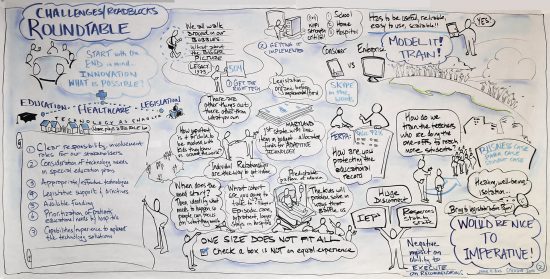At the end of 4th grade, 10-year-old Peyton Walton learned that she and her family were moving 600 miles away. She also learned that she was diagnosed with cancer.
Peyton’s mother Lynn knew how important school was to Peyton. Lynn knew that if Peyton could continue to stay in school, it would have a tremendous impact on her mental outlook.
So, as Peyton began her cancer treatment, Lynn began a focused effort to help her daughter acquire the remote access to the classroom she needed. She came across many roadblocks, some of which she was able to overcome, and some that were insurmountable.
According to Lynn, “It was important for me to connect her [Peyton] to children and people that knew her before cancer. Because then she was just Peyton.”
After tackling many roadblocks with her healthcare providers, local legislation, and school district, Peyton and Lynn were connected with Cisco, and were given video collaboration units to help Peyton learn virtually, from her home or from the hospital. The collaboration technology that helped her stay connected academically also helped her remain engaged with her classmates and teachers, and feel included in her social network.

“When we got the equipment, I saw how well it worked and how clear it was,” said Peyton’s teacher, Mrs. Krumm. “She’s sitting in the room almost with you…it was very exciting.”
Lynn clearly saw the effect the virtual learning experience had on Peyton, “It was palpable. I could feel the immense impact this technology had on her mental outlook.”
Today, Peyton is cancer free, and her story opens up a world of possibilities for pediatric patients facing not only severe illnesses but also interruption of their education. Her story is also an inspiration for the countless ways we can leverage technology to drive inclusion and collaboration for people in other situations.
To help bridge the gap between the current standard of care and access to schooling, Cisco hosted Peyton, Lynn, and leaders in education and healthcare for a roundtable discussion during Cisco Live US.

During the event, participants explored the ideal future scenario in which we can regularly connect patients with an interactive educational experience and eliminate isolation through collaboration technology.
The day began with an inspirational talk from SVP and Chief People Officer, Francine Katsoudas. She said of the roundtable discussion, “This conversation is about the art of what’s possible.”
Following Fran’s talk, we were introduced to Lynn and Peyton. Lynn stressed not only the importance of learning in the classroom, but also learning from engagement with other students.
She said, “So much of what happens at school isn’t about facts – it’s about social engagement and self-reflection that is not taught. When you remove a child from those experiences, the most detrimental thing to prognosis is isolation. The main purpose of this tool was not about learning per say, it was about Peyton learning about herself.”

General Manager of Cisco’s Internet of Things (IoT) and Applications, Rowan Trollope, joined the group next, stressing the importance of collaboration technology in connecting people and things.
“This experience [collaboration] will happen in the future. Everyone will have access to it and more,” said Rowan. “It’s inevitable that this will happen – it’s our job to make it happen.”
After the inspiring speaking sessions, the floor was opened up to the attendees to discuss how to achieve a future scenario in which all patients are given educational access. Conversations were insightful and action-focused, as you can see by this illustration of the roundtable discussion.

One key takeaway from the day: With the right technology and the right leaders, we can provide quality educational experiences to everyone, regardless of location, age or physical state.
This commitment to connectivity bridges all parties – parents, students, teachers, hospitals, community members and legislators for the common good of expanding educational opportunities for all.


Peyton’s story is a great example of how important connections are and how we can use so-called business technology to have real human impact. When fighting challenges, connections to people are important. But so is being able to connect with and maintain what’s “normal” in life. For a kid, that’s school. Maintaining a connection to what’s normal takes some of the power away from what we’re fighting — because then our challenges are just something we’re facing, not everything we’re about.
Thank you for sharing your story Peyton!
Love this story! It’s just one of the many reasons I love working at Cisco.#makingadifference
What an incredible inspirational story! Peyton is one amazing young lady!
This is the really cool thing with where technology has got us, especially Collaboration technologies. This isn’t tech, this is people’s lives that we are impacting and making a real difference.
Article of interest given I was with colleagues today who talked about a similar story on TeDX.
Thanks!
Thanks for sharing this story, very touching and inspiring indeed !
Lance, thanks for so eloquently recapping the Roundtable. I look forward to working with you and Cisco to make this vision a reality.